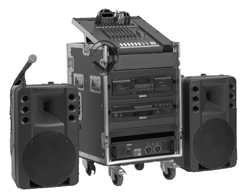
Consider Analog
Digital is all the rage right now, but for a portable system, I don’t mind going analog; though this is primarily a cost issue for me.
I have a lot of older, still working analog gear that worked great in my system. A couple of dbx 166A comps gives me four channels of compression, an SPX 990 works wonders on effects and the DriveRack PX works fine for basic PA tuning.
Add in a Furman for power and a rack drawer for sharpies, board tape, gaff and batteries and we’re ready to roll. I’m short just two channels of wireless for our system, and I’m still debating what I’ll buy for that.
While digital is nice in that does package all that outboard gear in one box (a Yamaha 01V could work really well), it’s a lot of money if you have to go buy one.
And given how infrequently we use our system (5-6 times a year), it’s too much money for me to tie up sitting in a closet. Of course, if you have an 01V sitting around…
Keep It Self-Contained
One of my biggest goals for my portable system is to make sure I have everything I will need in the case without having to pull anything from my regular stock. That includes patch cords, mic cables, extension cords, etc..
Now, I do sometimes break that rule when it comes to mics. If I’m doing a retreat and need a few DIs and drum mics, I will pull from my regular mic locker.
Again, it doesn’t make sense to me to have $1,000 in mics and DIs sitting in a closet most of the year, waiting for that occasional outside event.
However, as much as possible, I want to be able to grab the racks and cases and go; I don’t want to be grabbing a ton of stuff from main stage to make it happen.
Consider your possible needs for cabling, then assemble those cables in a rack, box, or other rolling container and keep them there. You might even want to label them.
Adjust As Needed
Now, the system that I’m describing is very basic and handles small events very well. If you find yourself doing outdoor worship services multiple times a year, or other larger events, you should consider the cost of building your own portable system versus renting what you need. You may find that simply renting a PA for the day will get you better quality at a lower cost than you could afford to buy.
On the other hand, if you need it often enough, it may make sense to build your own system. Keep in mind, you could ease into it.
Start by renting the whole system to figure out what you need. Then build your own front of house rack with mixer and other gear, but rent the speakers. When it makes sense, buy loudspeakers.
Obviously, this is not a comprehensive guide, but hopefully it gives you some ideas and a launching off point.
Mike Sessler is the Technical Director at Coast Hills Community Church in Aliso Viejo, CA. He has been involved in live production for over 20 years and is the author of the blog, Church Tech Arts . He also hosts a weekly podcast called Church Tech Weekly on the TechArtsNetwork.
